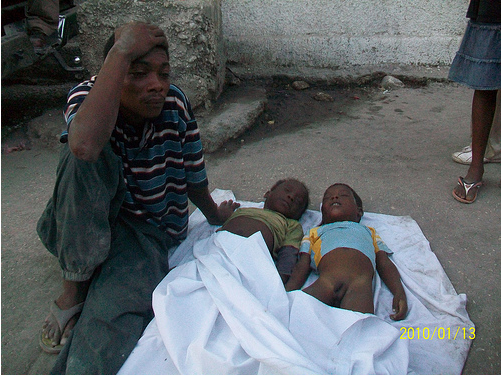Haiti Earthquake: The Mourning After Pt.2 (Video)
June 10th, 2010
Man sits outside Médecins Sans Frontières (MSF) the day after Haiti's earthquake. "God gives them and God takes them away," he said. (Photo by Vladimir Leguerre)
Yes, I’m very late in posting this video from the morning after the earthquake struck Haiti. When the earthquake hit, I was in Port-au-Prince with Vladimir Leguerre, my fixer (and a journalist in his own right). We walked from Port-au-Prince to Carrefour, where he lives. In short, the video in this post is a continuation of what we saw on our way back the next morning.
While I was documenting this, my heart sank into my stomach. And it stayed there, tucked out of reach for the most part, which enabled me to continue pushing my camera or microphone into the faces of these victims.
But I was also astonished by how much many of them wanted to share their losses. They wanted to reveal to the world, or some stranger with a camera who seemed to care, that they were in pain. Perhaps talking to a person in some sort of official capacity helped validate their losses, allowed them to record the lives and deaths of the people they loved. After all, in a few days, many of the bodies would be scooped up by trucks or dropped off at dumping locations to be buried in mass graves, unidentified. At the risk of sounding all pseudo-psychologist-y, it did seem as if it was their first attempt at therapy, talking out their grief. I saw this time and again. There were people gazing at the bodies of their loved-ones who were buried up to their heads in the rubble. And sometimes without breaking gaze, they would talk to reporters willingly.
The man in this video with his young sons lying next to him was mourning all alone. Smoking a cigarette. He wanted someone to see his pain, I’m sure. Someone needed to check it off a box on a checklist of hurt, register his loss. It appears, based on his words -”God gives them and he takes them away”-that he had chalked it up to God’s will. But there was the need to convey that to anyone who would listen.
I shed no tears while in Haiti. Maybe I was simply scared for my own safety or perhaps I was in reporter mode and saw the tragedy as a story that needed to be mounted and conquered. But when you come home, safe in your own environment, the wall that held back emotion shatters. Every reporter I talked to who covered the quake mentions at least one image they cannot quite shake, their personal tipping point. The image or the moment that comes to represent the thing to them. For me, it was the little girl in the picture above. Even with my heart in my stomach, that image was hard to set aside. Naturally, it would seem to connect because I am the father of two girls. But I didn’t feel it on that level. It was because she was alone there. No one sat with her. As sad as the image of the man and is two sons was, I felt weirdly comforted knowing that the two boys had someone there, even though they were not alive to see. But this girl, carefully dressed and randomly placed, laid there with no one to even shoo the flies from her eyes.
I buried this image for the next few days as I went about the dirty business of snapping pictures of the pain and documenting the fall-out. I pushed it away as I took an adrenaline-fueled helicopter flight, which launched from the lush PetronVille Country Club-over the mountains, beyond bodies of water and through picturesque landscapes, which included a rainbow.
(Photo: V. Leguerre)
While on the flight back home the images played in my mind, as if for the first time. Deconstructing these images is a heartbreaking exercise the mind cannot easily resist. There was the lady chanting as she stared helplessly at the torso of her daughter, who can be seen holding her grand daughter tight to her bosom under a pile of rubble. The lady could only look on from a distance and share that it was her daughter there, the second one she lost this year.
Another man protested me taking pictures of his brother, whose head and arms stuck out of a fallen building. He later relented, through tears. “I’m sorry,” he said, “He just wasn’t supposed to die this way.” He hadn’t resigned his loss to the workings of a higher power like the man with his two boys.
And then there was the image of the little girl. Her eyes slightly looking on, the flies preying on her solitude. The little girl has come to represent, to me, the worst possible outcome of the tragedy-dying alone. And the man who sat with his dead sons represents the equally horrifying flip side-living alone, grieving alone. It is very likely that the little girl was buried in some mass grave unidentified. It is also possible that she was not alone at all. That her loved ones-realizing, much like the spokesperson at the UN, that there was nothing more to be done for the dead-had made their peace with the child and turned their attention to the living.
[...] front of the Médicins Sans Frontières (Doctors Without Borders) hospital, there are bodies scattered on the ground. People step over an elderly lady’s carcass. A young girl’s small body lies unattended. Her [...]
mezanmi gade peyi mwen an